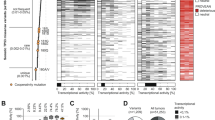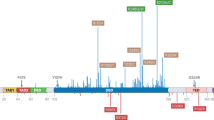Abstract
Many tumors overexpress mutant forms of p53. A growing number of studies suggest that the nature of a p53 mutation in a cell can impact upon cellular properties, clinical responses to therapy and prognosis of a tumor. To explore the cellular basis of these observations, experiments were designed to compare the properties of cells with and without p53 mutations within the same cell population. To that end, various tumor-derived human p53 mutants were introduced into p53-null H1299 lung adenocarcinoma cells. Clonogenic survival assays revealed that cells overexpressing the p53His175 mutant, but not the p53His273 mutant, recover preferentially from etoposide treatment. Moreover, p53His175 as well as p53His179 reduced substantially the rate of etoposide-induced apoptosis, whereas p53His273 and p53Trp248 had a much milder protective effect. In contrast, p53His175 and p53His273 exerted very similar effects on the cellular response to cisplatin; both conferred increased resistance to low concentrations of the drug (2.5 μg/ml), but did not protect at all against high concentrations (10 μg/ml). Hence particular p53 mutants may confer upon tumor cells a selective survival advantage during chemotherapy. These findings define a new type of mutant p53 selective gain of function, which may compromise the efficacy of cancer chemotherapy.
This is a preview of subscription content, access via your institution
Access options
Subscribe to this journal
Receive 50 print issues and online access
$259.00 per year
only $5.18 per issue
Buy this article
- Purchase on Springer Link
- Instant access to full article PDF
Prices may be subject to local taxes which are calculated during checkout






Similar content being viewed by others
References
Aas T, Borresen AL, Geisler S, Smith-Sorensen B, Johnsen H, Varhaug JE, Akslen LA and Lonning PE. . 1996 Nature Med. 2: 811–814.
Bergh J, Norberg T, Sjogren S, Lindgren A and Holmberg L. . 1995 Nature Med. 1: 1029–1034.
Borresen AL, Andersen TI, Eyfjord JE, Cornelis RS, Thorlacius S, Borg A, Johansson U, Theillet C, Scherneck S, Hartman S et al. 1995 Genes Chromosom. Cancer 14: 71–75.
Chin KV, Ueda K, Pastan I and Gottesman MM. . 1992 Science 255: 459–462.
Clarke AR, Purdie CA, Harrison DJ, Morris RG, Bird CC, Hooper ML and Wyllie A. . 1993 Nature 362: 849–852.
Cote RJDE, Groshen S, Jones PA and Skinner DG. . 1997 Nature 385: 123–124.
Darzynkiewicz Z. . 1995 J. Cell. Biochem. 58: 151–159.
Deb S, Jackson CT, Subler MA and Martin DW. . 1992 J. Virol. 66: 6164–6170.
Dittmer D, Pati S, Zambetti G, Chu S, Tereseky K, Moore M, Finlay C and Levine AJ. . 1993 Nature Genet. 4: 42–46.
El Rouby S, Thomas A, Costin D, Rosenberg C, Potmesil M, Silber R and Newcomb EW. . 1993 Blood 82: 3452–3459.
Fisher DE. . 1994 Cell 78: 539–542.
Fraizer MW, He X, Wang J, Gu Z, Cleveland JL and Zambetti GP. . 1998 Mol. Cell. Biol. 18: 3735–3743.
Fritsche M, Haessler C and Brandner G. . 1993 Oncogene 8: 307–318.
Goh H-S, Yao J and Wurl P. . 1995 Cancer Res. 55: 5217–5221.
Gualberto A, Aldape K, Kozakiewicz K and Tlsty TD. . 1998 Proc. Natl. Acad. Sci. USA 95: 5166–5171.
Hamada M, Fujiwara T, Hizuta A, Gochi A, Naomoto Y, Takakura N, Takahashi K, Roth JA, Tanaka N and Orita K. . 1996 J. Cancer Res. Clin. Oncol. 122: 360–365.
Hansen R and Oren M. . 1997 Curr. Op. Genet. Dev. 7: 46–51.
Haupt Y, Rowan S, Shaulian E, Vousden KH and Oren M. . 1995 Genes Dev. 9: 2170–2183.
Hinds PW, Finlay CA, Quartin RS, Baker SJ, Fearon ER, Vogelstein B and Levine AJ. . 1990 Cell Growth Diff. 1: 571–580.
Hollstein M, Soussi T, Thomas G, von-Brevern M and Bartsch H. . 1997 Recent Results Cancer Res. 143: 369–389.
Hsiao M, Low J, Dorn E, Ku D, Pattengale P, Yeargin J and Haas M. . 1994 Am. J. Pathol. 145: 702–714.
Kastan MB, Onyekwere O, Sidransky D, Vogelstein B and Craig RW. . 1991 Cancer Res. 51: 6304–6311.
Kremenetskaya OS, Logacheva NP, Baryshnikov AY, Chumakov PM and Kopnin BP. . 1997 Oncol. Res. 9: 155–166.
Lanyi A, Deb D, Seymour RC, Ludes-Meyers JH, Subler MA and Deb S. . 1998 Oncogene 16: 3169–3176.
Levine AJ. . 1997 Cell 88: 323–331.
Li R, Sutphin DP, Schwartz D, Matas D, Almog N, Wolkowicz R, Goldfinger N, Pei H, Prokocimer M and Rotter V. . 1998 Oncogene 16: 3269–3278.
Lotem J and Sachs L. . 1995 Proc. Natl. Acad. Sci. USA 92: 9672–9676.
Lowe SW. . 1995 Curr. Opin. Oncol. 7: 547–553.
Lowe SW, Schmitt EM, Smith SW, Osborne BA and Jacks T. . 1993 Nature 362: 847–849.
Ludes-Meyers JH, Subler MA, Shivakumar CV, Munoz RM, Jiang P, Bigger JE, Brown DR, Deb SP and Deb S. . 1996 Mol. Cell. Biol. 16: 6009–6019.
Makris A, Powles TJ, Dowsett M and Allred C. . 1995 Lancet 345: 1181–1182.
Mathieu C, Koscielny S, Le Bihan ML, Spielmann M and Arriagada R. . 1995 Lancet 345: 1182.
Michalovitz D, Halevy O and Oren M. . 1991 J. Cell. Biochem. 45: 22–29.
Milner J. . 1995 Trends Biochem. Sci. 20: 49–51.
Mitsudomi T, Steinberg SM, Nau MM, Carbone D, D'Amico D, Bodner S, Oie HK, Linnoila RI, Mulshine JL, Minna JD et al. 1995 Oncogene 7: 171–180.
Peled A, Zipori D and Rotter V. . 1996 Cancer Res. 56: 2148–2156.
Reeve JG, Xiong J, Morgan J and Bleehen NM. . 1996 Br. J. Cancer 73: 1193–1200.
Ribiero JC, Barneston AR, Fisher RJ, Mameghan H and Russel PJ. . 1997 Int. J. Radiat. Biol. 72: 11–20.
Righetti SC, Della Torre G, Pilotti S, Menard S, Ottone F, Colnaghi MI, Pierotti MA, Lavarino C, Cornarotti M, Oriana S et al. 1996 Cancer Res. 56: 689–693.
Rusch V, Klimstra D, Venkatraman E, Oliver J, Martini N, Gralla R, Kris M and Dmitrovsky E. . 1995 Cancer Res. 55: 5038–5042.
Sakamuro D, Sabbatini P, White E and Prendergast GC. . 1997 Oncogene 15: 887–898.
Traubert H, Meye A and Wurl P. . 1996 Cancer Res. 56: 4134–4136.
Tsutsumi-Ishi Y, Tadokoro A, Hanaoka F and Tsuchida N. . 1995 Cell. Growth. Diff. 6: 1–8.
Walker KK and Levine AJ. . 1996 Proc. Natl. Acad. Sci. USA 93: 15335–15340.
Wang XW, Yeh H, Schaeffer L, Roy R, Moncollin V, Egly JM, Wang Z et al. 1996 Genes Dev. 10: 1219–1232.
Wattel E, Preudhomme C, Hecquet B, Vanrumbeke M, Quesnel B, Dervite I, Morel P and Fenaux P. . 1994 Blood 84: 3148–3157.
Wolf D, Harris N and Rotter V. . 1984 Cell 38: 119–126.
Zhan QM, Carrier F and Fornace AJ. . 1993 Mol. Cell. Biol. 13: 4242–4250.
Acknowledgements
We wish to thank T Unger, K Vousden and B Vogelstein for p53 expression plasmids and D Lane for DO-1. This work was supported in part by grant RO1 CA 40099 from the NCI, the Israel-USA Binational Science Foundation, and the Leo and Julia Forchheimer Center for Molecular Genetics. GB is a former AIRC fellowship. GB dedicates this work to SM.
Author information
Authors and Affiliations
Rights and permissions
About this article
Cite this article
Blandino, G., Levine, A. & Oren, M. Mutant p53 gain of function: differential effects of different p53 mutants on resistance of cultured cells to chemotherapy. Oncogene 18, 477–485 (1999). https://doi.org/10.1038/sj.onc.1202314
Received:
Revised:
Accepted:
Published:
Issue Date:
DOI: https://doi.org/10.1038/sj.onc.1202314
Keywords
This article is cited by
-
Chloroquine induces transitory attenuation of proliferation of human lung cancer cells through regulation of mutant P53 and YAP
Molecular Biology Reports (2023)
-
A role for bioinorganic chemistry in the reactivation of mutant p53 in cancer
JBIC Journal of Biological Inorganic Chemistry (2022)
-
Acquisition of aneuploidy drives mutant p53-associated gain-of-function phenotypes
Nature Communications (2021)
-
Structural basis of reactivation of oncogenic p53 mutants by a small molecule: methylene quinuclidinone (MQ)
Nature Communications (2021)
-
The oncogenic potential of a mutant TP53 gene explored in two spontaneous lung cancer mice models
BMC Cancer (2020)



